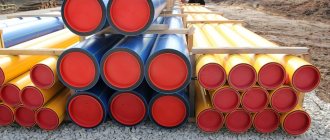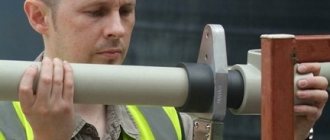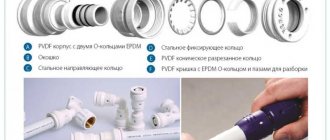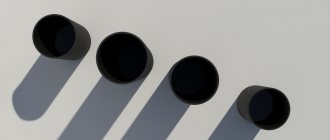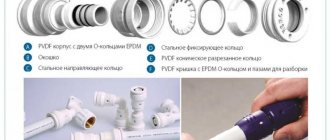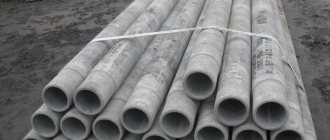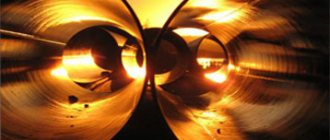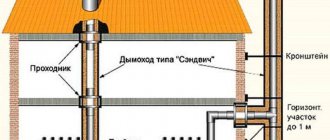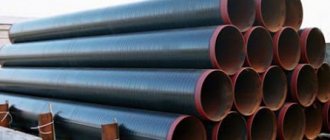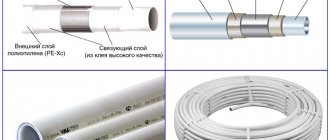Many regions of Russia experience harsh climatic conditions, and due to low temperatures, pipelines urgently need high-quality thermal insulation and the best option is insulation for pipes made of foamed polyethylene. It does not allow the coolant transported through the pipes to freeze, and also prevents freezing of the materials used to create the pipes (polymers, fiberglass and steel). Thermal insulation of communications is extremely necessary, since liquid frozen inside pipes can provoke not only the formation of traffic jams and stopping the flow, but also a violation of the integrity of structures, and this is the main cause of accidents in central water supply and sewerage systems. In order to prevent such situations, care should be taken in advance to ensure high-quality insulation of underground structures.
Underground heating and hot water supply systems also need good thermal insulation to minimize heat loss from the coolant or hot water inside the pipes. Insulation is also used for air conditioners and cold water supply systems; it prevents the formation of condensation, which is the main cause of destruction of important components and, as a result, premature failure of the entire system.
Basic requirements for insulation for pipes made of foamed polyethylene
To get the maximum effect from polyethylene foam pipe insulation, the selected material must meet certain requirements, in particular:
- low level of thermal conductivity - the lower this indicator, the less material is needed, this is especially important if insulation of an already installed pipeline system is required or when there is a need to save on the purchase of insulation;
- hydrophobicity - insulation must not only reliably protect communications from freezing, but also from moisture and corrosion. If foamed polyethylene constantly gets wet, this will inevitably lead to a decrease in its main properties;
- heat resistance - this indicator is extremely important for hot water supply systems, as well as heating, since in these cases the thermal insulation material must withstand high temperatures;
- resistance to various mechanical and atmospheric factors.
Thermal insulation made of foamed polyethylene is an excellent replacement for analogues.
XLPE insulation properties
For many years, oiled paper was used as cable insulation, which was neither durable nor stable in properties. It required a mandatory hard metal shell, since it was unstable to mechanical disturbances, was afraid of water and vertical laying, in which oil would flow to the lowest point of the wire. Nowadays, modern materials made from polymers, especially from the so-called “cross-linked” polyethylene, are increasingly replacing the paper insulation method.
Technical specifications
Cross-linked polyethylene is a polymer of ethylene hydrocarbon, modified at the molecular level to create a completely new structure. The system of intermolecular bonds of XPE obtained during the “cross-linking” process looks like a three-dimensional cellular network, similar to the crystal lattice of solid substances. This change gives special tensile strength and an increase in all other characteristics of polyethylene.
In comparison with both oil-filled and PVC insulation, cross-linked polyethylene provides much higher strength and dielectric characteristics, as can be seen from the table:
| Indicators | XLPE (PEX)-insulation | Oil insulation | PVC insulation |
| The highest temperature that the material can withstand for a long time, 0C | 90 | 85 | 70 |
| Emergency possible temperature, 0C | 130 | 90 | 80 |
| Maximum possible temperature during short circuit, 0C | 250 | 200 | 160 |
Maximum permissible short circuit current, A/mm2
| 144 93 | 101 67 | 125 81 |
| Dielectric constant at normal temperature (+20 0C) | 2,4 | 3,3 | 3,5 |
| Dielectric losses at normal temperature (+20 0C) | 0,001 | 0,004 | 0,02 |
INTERESTING! The lower temperature limit for the use of cross-linked polyethylene without changing its dielectric and strength characteristics is -500C, which distinguishes it from other polymers (PVC, polypropylene), the operating temperature range of which begins only from -15 0C.
Benefits of use
The use of XLPE for insulating power cables has made it possible to both expand the operational properties of electrical wiring and make its installation more convenient:
- The high dielectric properties of polyethylene with minimal dielectric losses solved the problem of insulating high-voltage lines,
- An increase in the maximum permissible temperature made it possible to increase the wire throughput by 20-30% compared to paper-oil analogues,
- Resistance to rapid temperature increases from operating to maximum values protected short circuit situations,
- The moisture resistance of PEX insulation eliminates the need for waterproofing,
- Resistance to mechanical damage eliminated the mandatory metal sheath for small-section wires, thereby lightening its weight and reducing the load on supporting structures during installation work,
- The elasticity of cross-linked polyethylene made the cable very flexible, which made it possible to freely change the direction of the laying and make it multi-level,
- Resistance to negative temperatures down to -50 0C without changing ductility made it possible to install electrical networks in winter conditions without preheating the cable.
Flaws
XLPE insulation, despite all its positive qualities, has the following disadvantages that limit its use:
- Polyethylene, even “cross-linked” samples, does not tolerate long-term exposure to ultraviolet radiation, so its use in places exposed to sunlight is undesirable.
- PEX materials are damaged by free oxygen from the air penetrating into their structure, and therefore the products require a special protective coating.
IMPORTANT! Due to the reduced service life of XLPE when used in exposed areas, while at the same time having ideal insulating properties in protected areas, it is used to make insulation that is in direct contact with the conductive metal core. The outer sheaths of the cable are made of other materials.
What is foamed polyethylene
Foamed polyethylene (PPE, polyethylene foam) belongs to foam plastics and is used as reliable thermal insulation for pipes in various engineering systems and air conditioning systems. Many people believe that the only polystyrene foam is polystyrene foam, but this opinion is wrong, since, unlike it, high-quality polyethylene foam retains elasticity even after polymerization.
The consistency of PPE is similar to foam rubber and does not withstand mechanical loads, which actually does not allow its use as a wall and floor thermal insulation layer. Due to the closed fine-cell porous structure, polyethylene foam does not absorb moisture and does not allow water vapor to pass through, has a low level of thermal conductivity and is resistant to corrosion, thus, pipe insulation made of polyethylene foam is the most effective, and it is convenient to install it on a pipeline under construction or already installed.
Products made of polyethylene foam and their scope
- Foil polyethylene foam - sold in rolls 1.0-1.2 meters wide. It is insulation made of chemically cross-linked polyethylene foam covered with polished aluminum foil. It is used for thermal insulation of walls, industrial equipment, and engineering systems. The most popular modifications: “A” (foil on one side), “B” (double-sided foil), “C” (one side is foil, the other has an adhesive coating), “ALP” (one-sided foil with a protective film), "Penofol" (foamed polyethylene with perforated foil coating) .
- Pipe shells are pipe shells with a clearly defined internal diameter. They can be produced with a ready-made technological cut along the entire length (for mounted pipes) or without a cut. Shells for pipes running outdoors are made with a protective polymer coating. Used as thermal insulation for utility hot water supply systems and air conditioning systems. Available with an outer diameter of 6-114 mm, foam thickness of polyethylene 6-25 mm.
- Compensation mats - used as shock-absorbing thermal insulation in places where hot water pipelines turn, for heat and sound insulation of walls, partitions, and floors. Mats are obtained by gluing panels of foamed polyethylene. The process occurs at high temperatures, so the body of the damping mat is an inextricable structure that is resistant to external damage. Compensation mats made of polyethylene foam are supplied in sheets, the standard size is 1x2 m, thickness from 10 to 100 mm.
- The harnesses are a cylindrical seal made of foamed polyethylene; products are produced with an outer diameter of Ø 6-120 mm. 1. Bundles Ø 6-12 mm are laid in expansion joints of concrete floors. Ø 12-20 mm seal the gaps between the wall and door or window frames. Well, the largest bundles in the range, Ø 20-60 mm, are used to fill joints in the walls of panel houses.
- Substrate - made of physically and chemically cross-linked PPE. Available in rolls up to 3 meters wide and 2-5 mm thick. A polyethylene foam backing is used as a backing layer between the screed and the laminate.
- Packaging polyethylene foam. Packaging usually uses uncrosslinked polyethylene foam in the form of rolls and bags of different sizes and thicknesses (0.5-20 mm). But there are also containers made to order - various inserts, protective corners. Polyethylene foam bags are the most popular type of packaging. They do not allow water to pass through, are durable, absorb shock and reduce vibration of the cargo during transportation. To make the bag more durable and improve its heat-insulating properties, it is covered on top with metallized polypropylene or regular film, nylon, or kraft paper. Packaging material made of polyethylene foam is used for transporting electrical equipment, furniture, dishes, and shoes.
Dimensions and diameters of insulation for pipes made of foamed polyethylene
There are several types of insulation on sale, regardless of their purpose; they are all created using the same technology, but have different thicknesses. Compared to sheet insulation materials used for walls and floors, pipe insulating material is produced in the form of cylinders or, in other words, shells with different external and internal diameters, which makes it possible to carry out thermal insulation of communications under construction or already installed without any problems.
The standard length of the tubes is 2 m, and their thickness and diameter vary depending on the size. Thus, the thickness can be 6, 9, 13, 20 or 32 mm, and the internal diameter can be from 6 to 200 mm (for industrial purposes, products with large parameters are used). To make the thermal insulation of communications more effective, different manufacturers focus on standard pipe sizes when producing thermal insulation products.
In order to insulate communications that are constantly exposed to ultraviolet rays, PPE with a colored surface is used, which reliably protects the heat insulator. There is also polyethylene with a foil surface that protects pipes from low and high temperatures. Another variety is rolled insulating material with special tape; such products are used to insulate communications in hard-to-reach places.
Diameters of insulation for pipes made of foamed polyethylene.
What is cross-linked polyethylene
Polymer materials
With a certain impact on simple polyethylene, it is possible to trigger some changes in the hydrogen atoms, in which new bonds arise between the carbon atoms. This process of obtaining new additional carbon bonds is called cross-linking. The high advantages of cross-linked polyethylene, achieved through enhanced joint development of scientists and manufacturers, are expressed in the following:
- long service life, up to 50 years;
- increased strength and flexibility;
- restoration of shape after damage;
- possibility for use in installation work on assembling heated floors;
- application in the assembly of heating systems and water pipes.
Intermolecular bonds: on the left - ordinary polyethylene, on the right - cross-linked
Cross-linked polyethylene also has fire-fighting properties and has excellent heat resistance to very high temperatures. And, on the contrary, due to the increased softness of cross-linked polyethylene, the products can easily withstand the increase in water that has frozen in them. For owners of country houses and summer cottages, a pipeline made of cross-linked polyethylene is an ideal option. All basic requirements will comply with the following standards:
- maintaining the required pressure;
- maintaining temperature mode;
- long service life, without any accidents.
Properties and characteristics of PEX pipes
When making cross-linked polyethylene, it is directly affected by various methods and substances. In this regard, the level of strength of pipe cross-linking changes and differs
A large figure reaches 85%. The cross-linking method is important, because depending on it, the number of additional bonds formed changes. I distinguish four stitching methods
The finished product is called PEX. The name is very simply deciphered: the first two letters indicate “polyethylene”, and the last letter is a symbol indicating cross-linking. Now the REHAU company is considered the leader in the production of cross-linked polyethylene, and its products are in demand in our country.
PEX pipe primarily consists of three layers:
- the inner first layer is cross-linked polyethylene;
- external – oxygen barrier made of ethylene vinyl glycol (EVON)
- connecting layer - glue.
The multilayer nature of the pipes is explained by the instability of the substance to UV rays, as well as the ability to transmit oxygen. Both contribute to rapid wear.
Specifications:
- minimum diameter up to 16 mm;
- extreme high temperature during operation in heating structures 90 -95 C;
- product wall up to 2 mm;
- weight per linear meter up to 110 g;
- thermal conductivity up to 0.39 W/mk., and density 940 kg/m3;
- the volume of liquid contained in the communication is up to 114 ml;
- operation of the pipeline when heated to +75C is guaranteed for up to 50 years, and at a critical temperature of 95 ºC and high pressure, this period is reduced to 15 years;
- resistant to solvents;
- With the help of special fittings, structures can be constructed in any direction and configuration.
Important! The process of making cross-linking occurs under the action of a flow of electrons. The result is a connection of free branches with very strong lateral bonds between atoms
The resulting crystal lattice shape is made of stronger, harder materials.
Main technical and operational characteristics
To understand the characteristics of foamed polyethylene, you should study the technical characteristics of this insulation; it is available in two types:
- Unstitched.
- Stitched.
The first type is a polymer, the molecules of which do not have additional connections in space, due to which the material has less elasticity, strength and density; when compressed, a characteristic crack is heard and the original shape is lost.
The second type is obtained by chemical or radiation methods, that is, between the PPE molecules under a specific external influence, not only linear, but also cross-links are formed, or in other words, “cross-linking”, that is, the material turns out dense, strong and elastic, and after its compression the original shape quickly is being restored. Therefore, in order for pipe insulation made of foamed polyethylene to be of high quality and effective, it is better to give preference to products belonging to the second group.
Main technical characteristics of cross-linked insulating material:
- thermal conductivity – from 0.037 to 0.04 W/m*K;
- density – 25/200 kg/m3;
- susceptibility to the effects of a humid environment – 0.9/1.1%;
- vapor permeability indicator – 1.8 mg/m*h*Pa;
- flammability group based on state standards – G1-G4;
- level of dimensional stability – high;
- noise absorption – 16 dB;
- operation at temperatures – from -60 to +90°С;
- service life – 80-100 years.
Basic properties
The properties of cross-linked polyethylene come from the capabilities of its polymer base and the characteristics of its molecular structure.
Structure
Ordinary polyethylene consists of large molecules with many free branches, freely “floating” in space. That is why, despite many positive properties, it is still a rather soft material with a relatively low melting point. The creators of cross-linked polyethylene were able to eliminate this drawback by strengthening the structure of the material while maintaining its positive characteristics.
Cross-linked polyethylene has a wide-cell network structure of molecular bonds. It is formed by the appearance in the molecular structure of the polymer, along with longitudinal connections, also of transverse ones in the form of chains of hydrogen atoms, uniting the molecules into a three-dimensional network. The individual strands of polyethylene produced by the polymerization reaction are tightly bound together. Such a “fabric” has a much higher molecular density and a higher specific gravity, and is also much stronger than its “fibrous” counterpart in both mechanical and physico-chemical senses.
Specifications
In addition to high density and strength, cross-linked polyethylene has a number of original properties, thanks to which polyethylene products have been introduced into almost all areas of modern human activity. Cross-linking the molecules gave him:
- The main thing is to increase the melting temperature. The modified polymer softens at temperatures above 150 0C, melts at 200 0C and burns at 400 0C with decomposition into water and carbon dioxide.
- With cross-linking, stiffness and tensile strength increased while the elongation at break decreased.
- This material does not change properties with a sharp change in environmental conditions, which is similar even to such durable metals as steel.
- Its resistance to chemical reagents and biological destroyers is very high,
- Compared to simple polyethylene, cross-linked polyethylene has a higher hydro- and vapor barrier,
- The possibility of “shape memory” has emerged, in which the polymer changes its property of plasticity to elasticity.
Flaws
Significant disadvantages of cross-linked polyethylene are the following properties:
- As with other ethylene polymers, it begins to slowly degrade when exposed to sunlight.
- The negative effect of oxygen when it penetrates into the structure of the material.
Both disadvantages can be eliminated by covering the products with protective shells made of other materials or by applying a layer of paint.
Advantages and disadvantages of foamed polyethylene
Main advantages of PPE:
- keeps warm;
- muffles noise;
- prevents the formation of condensation and corrosion on pipes, which reduce their service life;
- does not release toxins;
- retains its shape.
Due to these characteristics, the use of foamed polyethylene is especially recommended for protecting underground pipes of hot water supply and heating systems located below the soil freezing level. The properties of PPE minimize heat loss from heating pipes and hot water supply, that is, the temperature of the coolant or hot water is maintained until transported to the end consumer. But at the same time, manufacturers of heat insulators for pipes also note some disadvantages of their products - flammability, inability to withstand heavy loads and lack of resistance to UV rays.
Which is better to use metal-plastic or cross-linked polyethylene?
Nonwoven materials: classification and methods of application
Metal-plastic pipes and cross-linked polyethylene pipes are quite widely used in both water supply and heating systems.
Both types of pipes have earned their widespread use due to the reliability of their operation. But, like all materials without exception, they have their pros and cons, unfortunately, you can’t live without them. Let's now take a closer look at each of these pipes and draw parallels between them in order to understand what is better: metal-plastic or cross-linked polyethylene.
Let's start with a metal-plastic pipe
This pipe consists of several layers, as is clearly demonstrated in the figure below.
The inner layer is often represented by cross-linked polyethylene, the smooth surface of which prevents carbonate deposits on its inner wall and protects the pipe from an aggressive environment.
The aluminum layer acts as reinforcement for the entire pipe and prevents the penetration of free oxygen into the medium it transports, which is an important characteristic when using the pipe in a heating system. After all, oxygen has a merciless and destructive effect on metal heating elements, reducing their service life by several times.
The top layer of a metal-plastic pipe consists of either polypropylene or the same material as the inner layers. This layer protects the aluminum layer from mechanical damage and chemical influences on it, and also gives the overall strength of the entire pipe.
The metal-plastic pipe can withstand high pressure while simultaneously being exposed to high temperatures.
If we list all the main advantages of a metal-plastic pipe, it will look like this:
- Protection against oxygen penetration when used in a heating system, in particular for heated floors
- Anti-corrosion properties of the pipe, that is, it does not rust and is not subject to electrochemical corrosion.
- Maximum operating pressure 10 atmospheres at maximum temperature 95 C
- Service life up to 50 years, subject to compliance with operating conditions
- Ease of installation. The pipe bends well by hand, which makes it possible to do without unnecessary connections.
- Low coefficient of thermal expansion
The disadvantages of metal-plastic pipes include the following:
- Different coefficients of linear expansion of pipe layers can cause their delamination. For the same reason, fitting joints may leak from time to time.
- If over-tightened, the threaded fitting may cut through the pipe.
- When water freezes in a pipe, it can burst.
- When bent, the pipe may break. It’s good that this will be a short section that you won’t mind replacing. And if you are laying a pipe in a heated floor, where it is necessary to make a lot of bends, and let’s say this happened to you, you will have to replace this circuit completely, because connecting the pipe in a heated floor screed is extremely undesirable.
Now consider a cross-linked polyethylene pipe
Polyethylene is cross-linked at the molecular level in various ways. It is designated by the PEX marking. We won’t go into production technology, because that’s not what the article is about.
Stitching gives the pipe additional strength and durability
The advantages of cross-linked polyethylene pipes include:
- Anti-oxygen barrier. Manufacturers apply a layer to the pipe that prevents the passage of free oxygen. This figure is not zero, but complies with German DIN standards.
- Easy to install
- Working pressure up to 20 atmospheres at a maximum temperature of 95 C with a permissible short-term increase up to 110 C
- Low noise level
- Pipe operation is about 50 years, subject to compliance with operational characteristics
- The pipe is resistant to water freezing in it
- Cross-linked polyethylene has molecular memory, which is a big plus. If in the case of a metal-plastic pipe, if the pipe is broken, it will have to be replaced, if it is a warm floor, or cut off at the bend and connected with a fitting, provided that the pipe will always be in an accessible place in the future. In the case of a PEX pipe, it is enough to heat the bend to 100 C and it will return to its original state.
Kink of a cross-linked polyethylene pipe before and after heating
Disadvantages of polyethylene pipe made from cross-linked polyethylene:
Undesirable exposure to direct sunlight. Significant difference in linear elongation when heated compared to metal-plastic. The anti-diffusion layer, which prevents the penetration of oxygen, is located on the outer surface of the pipe, so it is easily damaged if installed carelessly.
As you can see, each of these types of pipes has its own pros and cons, and it is impossible to understand which is better than metal-plastic or cross-linked polyethylene. It is for this reason that both types of pipes are widely used, but for warm floors the choice is still made more towards PEX pipes.
Installation of insulation
Let's consider the features of installing insulation on communications under construction and already assembled. So, in order to thermally insulate pipes at the assembly stage, you will need to carry out the following steps:
- place the pipes in the cylinders;
- Treat joints with adhesive;
- secure the joints with special tape.
Do-it-yourself insulation installation.
If installation of material on an already finished structure is required, then:
- each cylinder must be cut to the size of the insulated pipelines;
- cut the cylinders lengthwise and put them on the pipes;
- Securely seal cuts and joints.
With proper installation, the thermal insulation material will last a long time without reducing its original properties or deformation.
Installation nuances
Polyethylene foam thermal insulation can be easily installed on pipelines of any complexity. This does not require special devices. To make installation even easier, the insulating tubes have cuts. However, there are also monolithic insulators that can be easily cut to length using an ordinary stationery knife with a replaceable blade. A self-cut cylinder placed on a pipe will have to be fixed in one place, secured on top with pipe tape.
The edges of the shell are connected with special clips and secured with tape.
Installation of insulating shell:
- Before installing the heat insulator, the pipe surface of the pipe is cleaned of mortar and dirt to ensure a tight fit. If the utility network is made of metal, anti-corrosion cleaning is carried out.
- The incision is glued together with a special adhesive composition (“Akrol contact”, “QUIK-BOND”, “Neoprene 2136”, “88-NP”). Also, using glue, the beginning and end of the case are attached to the pipe section.
- After connecting the edges, the joint is secured with staples in increments of approximately 20 cm. After the adhesive has dried, the staples are removed and the seam is taped with reinforced tape.
It is necessary to glue the cut along the entire length if the street pipeline is insulated. For engineering structures indoors, you can only fix the edges and cover the seam with tape. It is important that the internal cross-section of the case exactly matches the size of the pipeline. If the end edge is self-adhesive, installation is even easier. You just need to remove the protective film and fix the cut.
Low price combined with low heat loss and long service life make foamed polyethylene attractive for use as a heat insulator. Simplicity of installation allows you to carry out the work yourself, without the involvement of specialists.
What is Penofol and its analogues
Thin polymer insulation is made from the following materials:
- The main insulating layer is foamed polyethylene 3...10 mm thick with closed air pores. The thermal conductivity coefficient λ of this layer lies in the range of 0.037–0.051 W/(m • °C) depending on operating conditions.
- The outer reflective layer is aluminum foil 14 microns thick, securely glued to a polymer base.
- The third layer on the back side of the polyethylene can be glue for ease of installation or the same aluminum.
A special feature of the material is its impermeability to moisture, the declared indicator is simply scanty - 0.001 mg/m • h • Pa. The insulation is quite light - the density ranges from 16...35 kg/m³, and is sold in rolls. Thanks to these parameters, the material serves well as an internal vapor barrier.
"Penofol" is available in 3 versions:
- double layer type A;
- three-layer – the base is coated with aluminum on both sides (type B);
- the same, with an adhesive layer - Type C.
The foil side works as a reflector of the radiant (infrared) component, polyethylene foam resists direct heat transfer. For exterior wall cladding, a perforated version of Penofol, shown in the photo, is offered. Many small holes are designed to allow water vapor to escape from the thickness of building structures.
External wall cladding is made with special insulation with perforation
Varieties and their differences
Foam polymers are divided into types of manufacturing, on which the quality and price of products depend:
| Non-crosslinked polyethylene foam | It is made from budget material, so its price is lower. It is used for laying insulating layers or packaging electrical equipment. It is rarely used for other purposes. |
| Chemically cross-linked polyethylene foam | To create this type of material, chemicals are used. additives (most often hydrogen peroxide or other catalysts). The result is polyethylene that is several times higher quality and denser than non-crosslinked polyethylene. |
| Physically cross-linked polyethylene foam | Solid-state electron emitters are used for production. Radioactive substances are located around the polymer raw material and punch microscopic holes with electrons. The density of the material in this way becomes as high as possible. This type of product is excellent for making pipe shells, creating a protective layer around the pipe, but it does a worse job of thermal insulation. This is the most expensive type of foamed polyethylene. |
We recommend that you familiarize yourself with: High-quality corrugated stainless steel pipes
The largest manufacturers represented on the market in Russia
The best guide in terms of product quality is the name of the manufacturer. So who can you trust?
- Armacell is a large German company that also produces thermal insulation based on polyethylene foam. It is sold under the Tubolit brand in almost all countries of the world. Products have become synonymous with the highest quality, since their manufacturing technology is constantly being improved, numerous studies are carried out, equipment is updated, and the range is expanded so that the materials are as effective and easy to use as possible. All this allows the company to occupy a leading position in the world.
- Odeflex is a Turkish manufacturer that offers foamed polyethylene in tubes and rolls. A few years ago, the products of this company were widely represented on the domestic market, but now they are increasingly being replaced by national manufacturers.
- Stroytekhizolatsiya LLC is a company located in Belarus and actively exporting its products to the Russian market. The range includes tubes of different thicknesses and diameters intended for thermal insulation of pipelines, air conditioning systems, and industrial systems. They are sold under the name Steinoflex 400 and have a longitudinal cut that facilitates the installation process. Steinophon 290 is also produced - a universal heat and sound insulating material, which is supplied in the form of mats of different thicknesses without coating, or foil-coated on one or both sides.
- Bilaveri is a large Ukrainian manufacturer of foamed polyethylene. The range includes roll material, with or without foil covering, pipe insulation and sealing harnesses. The company values its reputation, therefore it produces only the highest quality products, confirmed by numerous certificates. The manufacturer is widely known on the Ukrainian market and is beginning to conquer the CIS countries.
- Euroizolyatsiya Plus LLC is a domestic company that has been known in the foamed polyethylene market since 2008. The products are known under the Euroizolyatsiya brand and are produced on the most modern equipment using new technologies that are constantly being improved. The quality of manufactured products is supported by relevant documentation, incl. certificate of conformity and sanitary-epidemiological conclusion. The range includes polyethylene foam mats, pipe insulation, damper tape, self-adhesive insulation, underfloor heating, foil insulation.
is the largest Russian manufacturer of thermal insulation materials made of foamed polyethylene. The company is located in Voronezh, has been operating since 2006, distributes its products throughout the country and to neighboring countries. The manufacturer is trying to constantly improve production technology and expand the range of products, so now its products are represented by a huge range from substrate and reflective insulation to mats and harnesses.
LLC "Izodom"- OJSC Izhevsk Plastics Plant is an enterprise that was founded back in 1985. At the beginning of this century, the production of foamed polyethylene was mastered: it is produced both cross-linked and non-cross-linked, and the range of products is constantly expanding.
- ETIOL LLC is a company that was formed in 1991 on the site of Polymersintez OJSC. It is engaged in plastic processing, and recently began producing foamed polyethylene, which is already actively used in various fields throughout the country.
The article was written for the site.
Tags: Sound insulation, Wall insulation
The main advantages of polyethylene foam
Non-crosslinked foam insulation is in great demand due to its relatively low price and good technical characteristics. Its main advantages are:
- Low thermal conductivity, which gives a high thermal insulation coefficient.
- Resistance to low temperatures, thanks to which NPE retains all its qualities even at -60.
- Interaction with construction and finishing materials (wood, plaster, concrete, metal).
- Minimum weight.
- Environmental Safety.
- Resistance to the external environment and aggressive components (oils, gasoline, acids, alkali).
- Strength, durability (up to 100 years of service).
- Immunity to rot, fungi and other harmful microorganisms.
- Sound absorption properties, protection against electromagnetic radiation.
- Moisture resistance.
- Elasticity, ease of installation and transportation.
Disadvantages include sensitivity to ultraviolet light. NPE begins to deteriorate under its influence, so it should be used and stored out of reach of sunlight.
It can also be protected with opaque film or foil, which in turn will enhance heat retention.
What to look for when choosing
When choosing thermal insulation, the location of the pipes, the density of the material and its size are taken into account:
- To ensure tightness, it is important that the diameter of the insulating tube matches the size of the pipe itself: the material must be in close contact with its surface.
- The thickness of the walls depends on the temperature in the coolant and the lower limit of temperature values in the external environment, as well as on the purpose of thermal insulation: protection against freezing, preventing the appearance of moisture on the surface or ensuring the desired temperature on the coating requires the selection of a thermal insulation layer of different thicknesses.
Note! In places where pipes are located on the surface under the sun's rays, foamed polyethylene with a protective polymer layer is used.
One of the important parameters when choosing is the size of the material cells. The smaller the size, the greater its ability to retain heat:
We recommend that you read: How to make and install a protective exhaust hood on a chimney
| Purpose | Size |
| insulation for cold water pipes | 9 mm |
| insulation for heating and hot water systems | 13-20 mm |
| pipes under screed or in walls | 6 mm |
Pipe insulation
Today, when energy prices are constantly rising, reducing heat loss has become one of the important saving points. Pipe insulation with modern high-quality materials fully meets these needs.
Thermal insulation of pipelines can significantly reduce not only heat loss in the system, but also prevent the occurrence of other problems. The solution to this kind of problem can be technologically competent PVC insulation.
Most modern materials used for insulation of communications are attractive due to the low cost of installation work, the high speed of their implementation and reliability. Thermal insulation of pipelines is carried out using materials based on foam rubber (pipe insulation K-Flex), or polyethylene, in some cases with an additional aluminum coating.

